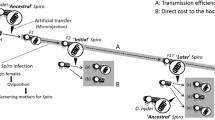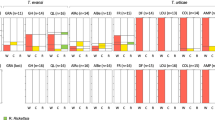Abstract
Insects engage in mutualistic relationships with a wide variety of microorganisms that are usually transmitted vertically to the next generation. During transmission, the symbiont populations often suffer significant bottlenecks that may entail major genetic and genomic consequences. Here we investigated the life-cycle and the severity of transmission bottlenecks in a symbiotic system with an unusual way of post-hatch vertical transmission by using quantitative PCRs and morphological 3D-reconstructions. European beewolves (Philanthus triangulum, Hymenoptera: Crabronidae) harbor symbiotic bacteria (‘Candidatus Streptomyces philanthi’) in specialized antennal gland reservoirs and secrete them into their subterranean brood cells. The symbionts are later taken up by the beewolf larva and incorporated into the cocoon material to provide protection against pathogenic microorganisms. Even after months of hibernation, the symbiont population on the cocoon is estimated to encompass around 1.4 × 105 cells. However, our results indicate that only few of these bacterial cells (about 9.7 × 102) are taken up from the cocoon by the emerging female. The symbiont population subsequently undergoes logistic growth within the antennal gland reservoirs and reaches a maximum of about 1.5 × 107 cells 3–4 days after emergence. The maximum specific growth rate is estimated to be 0.084–0.105 h−1. With a total reduction in cell numbers of about 6.7 × 10−5 during vertical transmission, the symbiont population experiences one of the most severe bottlenecks known for any symbiotic system to date. This extreme bottleneck may have significantly affected the evolution of the beewolf-Streptomyces symbiosis by increased genetic drift, an accumulation of mildly deleterious mutations and genome erosion.



Similar content being viewed by others
Abbreviations
- qPCR:
-
Quantitative PCR
References
Akman L, Yamashita A, Watanabe H, Oshima K, Shiba T, Hattori M, Aksoy S (2002) Genome sequence of the endocellular obligate symbiont of tsetse flies, Wigglesworthia glossinidia. Nat Genet 32:402–407
Aksoy S, Chen X, Hypsa V (1997) Phylogeny and potential transmission routes of midgut-associated endosymbionts of tsetse (Diptera: Glossinidae). Insect Mol Biol 6:183–190
Anbutsu H, Fukatsu T (2003) Population dynamics of male-killing and non-male-killing spiroplasmas in Drosophila melanogaster. Appl Environ Microbiol 69:1428–1434
Andersson SG, Kurland CG (1998) Reductive evolution of resident genomes. Trends Microbiol 6:263–268
Anukool U, Gaze WH, Wellington EM (2004) In situ monitoring of streptothricin production by Streptomyces rochei F20 in soil and rhizosphere. Appl Environ Microbiol 70:5222–5228
Baumann P, Moran NA (1997) Non-cultivable microorganisms from symbiotic associations of insects and other hosts. Anton Leeuw Int J G 72:39–48
Bourtzis K, Miller TA (2003) Insect symbiosis. CRC Press, Boca Raton, Florida
Buchner P (1965) Endosymbiosis of animals with plant microorganisms. Interscience Publishers, New York
Chater KF (1993) Genetics of differentiation in Streptomyces. Annu Rev Microbiol 47:685–713
Cox RA (2004) Quantitative relationships for specific growth rates and macromolecular compositions of Mycobacterium tuberculosis, Streptomyces coelicolor A3(2) and Escherichia coli B/r: an integrative theoretical approach. Microbiology 150:1413–1426
Currie CR, Scott JA, Summerbell RC, Malloch D (1999) Fungus-growing ants use antibiotic-producing bacteria to control garden parasites. Nature 398:701–704
Daae EB, Ison AP (1998) A simple structured model describing the growth of Streptomyces lividans. Biotechnol Bioeng 58:263–266
Degnan PH, Lazarus AB, Brock CD, Wernegreen JJ (2004) Host-symbiont stability and fast evolutionary rates in an ant-bacterium association: Cospeciation of Camponotus species and their endosymbionts, Candidatus Blochmannia. Syst Biol 53:95–110
Degnan PH, Lazarus AB, Wernegreen JJ (2005) Genome sequence of Blochmannia pennsylvanicus indicates parallel evolutionary trends among bacterial mutualists of insects. Genome Res 15:1023–1033
Douglas AE (1998) Nutritional interactions in insect-microbial symbioses: aphids and their symbiotic bacteria Buchnera. Annu Rev Entomol 43:17–37
Douglas AE (2006) Phloem-sap feeding by animals: problems and solutions. J Exp Bot 57:747–754
Fukatsu T, Hosokawa T (2002) Capsule-transmitted gut symbiotic bacterium of the Japanese common plataspid stinkbug, Megacopta punctatissima. Appl Environ Microbiol 68:389–396
Gabriel W, Lynch M, Bürger R (1993) Muller’s ratchet and mutational meltdowns. Evolution 47:1744–1757
Gil R, Silva FJ, Zientz E et al (2003) The genome sequence of Blochmannia floridanus: comparative analysis of reduced genomes. Proc Natl Acad Sci USA 100:9388–9393
Gil R, Latorre A, Moya A (2004) Bacterial endosymbionts of insects: insights from comparative genomics. Environ Microbiol 6:1109–1122
Goettler W, Kaltenpoth M, Herzner G, Strohm E (2007) Morphology and ultrastructure of a bacteria cultivation organ: the antennal glands of female European beewolves, Philanthus triangulum (Hymenoptera, Crabronidae). Arthropod Struct Dev 36:1–9
Holt JG, Krieg NR, Sneath PHA, Staley JT, Williams ST (1994) Bergey’s manual of determinative bacteriology. Williams & Wilkins, Baltimore, MA
Hosokawa T, Kikuchi Y, Meng XY, Fukatsu T (2005) The making of symbiont capsule in the plataspid stinkbug Megacopta punctatissima. FEMS Microbiol Ecol 54:471–477
Hosokawa T, Kikuchi Y, Fukatsu T (2007) How many symbionts are provided by mothers, acquired by offspring, and needed for successful vertical transmission in an obligate insect-bacterium mutualism? Mol Ecol 16:5316–5325
Ijichi N, Kondo N, Matsumoto R, Shimada M, Ishikawa H, Fukatsu T (2002) Internal spatiotemporal population dynamics of infection with three Wolbachia strains in the adzuki bean beetle, Callosobruchus chinensis (Coleoptera: Bruchidae). Appl Environ Microbiol 68:4074–4080
Ishikawa H (2003) Insect symbiosis: an introduction. In: Bourtzis K, Miller TA (eds) Insect symbiosis. CRC Press, Boca Raton, Florida., pp 1–21
Jonsbu E, McIntyre M, Nielsen J (2002) The influence of carbon sources and morphology on nystatin production by Streptomyces noursei. J Biotechnol 95:133–144
Kaltenpoth M, Goettler W, Herzner G, Strohm E (2005) Symbiotic bacteria protect wasp larvae from fungal infestation. Curr Biol 15:475–479
Kaltenpoth M, Goettler W, Dale C, Stubblefield JW, Herzner G, Roeser-Mueller K, Strohm E (2006) ‘Candidatus Streptomyces philanthi’, an endosymbiotic streptomycete in the antennae of Philanthus digger wasps. Int J Syst Evol Microbiol 56:1403–1411
Kikuchi Y, Hosokawa T, Fukatsu T (2007) Insect-microbe mutualism without vertical transmission: a stinkbug acquires a beneficial gut symbiont from the environment every generation. Appl Environ Microbiol 73:4308–4316
Kikuchi Y, Hosokawa T, Nikoh N, Meng XY, Kamagata Y, Fukatsu T (2009) Host-symbiont co-speciation and reductive genome evolution in gut symbiotic bacteria of acanthosomatid stinkbugs. Bmc Biology 7:2
Kim E, Kim H, Hong SP, Kang KH, Kho YH, Park YH (1993) Gene organization and primary structure of a ribosomal RNA gene cluster from Streptomyces griseus subsp. griseus. Gene 132:21–31
Komaki K, Ishikawa H (1999) Intracellular bacterial symbionts of aphids possess many genomic copies per bacterium. J Mol Evol 48:717–722
Komaki K, Ishikawa H (2000) Genomic copy number of intracellular bacterial symbionts of aphids varies in response to developmental stage and morph of their host. Insect Biochem Mol Biol 30:253–258
Lee C, Kim J, Shin SG, Hwang S (2006) Absolute and relative QPCR quantification of plasmid copy number in Escherichia coli. J Biotechnol 123:273–280
Lee C, Lee S, Shin SG, Hwang S (2008) Real-time PCR determination of rRNA gene copy number: absolute and relative quantification assays with Escherichia coli. Appl Microbiol Biotechnol 78:371–376
Lynch M, Gabriel W (1990) Mutation load and the survival of small populations. Evolution 44:1725–1737
Lynch M, Burger R, Butcher D, Gabriel W (1993) The mutational meltdown in asexual populations. J Hered 84:339–344
McCutcheon JP, Moran NA (2007) Parallel genomic evolution and metabolic interdependence in an ancient symbiosis. Proc Natl Acad Sci USA 104:19392–19397
Mira A, Moran NA (2002) Estimating population size and transmission bottlenecks in maternally transmitted endosymbiotic bacteria. Microb Ecol 44:137–143
Moran NA (1996) Accelerated evolution and Muller’s rachet in endosymbiotic bacteria. Proc Natl Acad Sci USA 93:2873–2878
Moran NA, Plague GR (2004) Genomic changes following host restriction in bacteria. Curr Opin Genet Dev 14:627–633
Nardon P (2006) Oogenesis and transmission of symbiotic bacteria in the weevil Sitophilus oryzae L. (Coleoptera: Dryophthoridae). Ann Soc Entomol Fr 42:129–164
Nardon P, Grenier AM (1988) Genetical and biochemical interactions between the host and its endocytobiotes in the weevils Sitophilus (Coleoptera, Curculionidae) and other related species. In: Scannerini S, Smith D, Bonfante-Fasolo P, Gianinazzi-Pearson V (eds) Cell to cell signals in plant. animal and microbial symbiosis. Springer, Berlin., pp 255–270
Ohnishi Y, Ishikawa J, Hara H, Suzuki H, Ikenoya M, Ikeda H, Yamashita A, Hattori M, Horinouchi S (2008) Genome sequence of the streptomycin-producing microorganism Streptomyces griseus IFO 13350. J Bacteriol 190:4050–4060
Oliver KM, Russell JA, Moran NA, Hunter MS (2003) Facultative bacterial symbionts in aphids confer resistance to parasitic wasps. Proc Natl Acad Sci USA 100:1803–1807
Omura S, Ikeda H, Ishikawa J et al (2001) Genome sequence of an industrial microorganism Streptomyces avermitilis: deducing the ability of producing secondary metabolites. Proc Natl Acad Sci USA 98:12215–12220
Pais R, Lohs C, Wu YN, Wang JW, Aksoy S (2008) The obligate mutualist Wigglesworthia glossinidia influences reproduction, digestion, and immunity processes of its host, the tsetse fly. Appl Environ Microbiol 74:5965–5974
Pettersson ME, Berg OG (2007) Muller’s ratchet in symbiont populations. Genetica 130:199–211
Prado SS, Rubinoff D, Almeida RPP (2006) Vertical transmission of a pentatomid caeca-associated symbiont. Ann Entomol Soc Am 99:577–585
Reichl U, King R, Gilles ED (1992) Effect of temperature and medium composition on mycelial growth of Streptomyces tendae in submerged culture. J Basic Microb 32:193–200
Rispe C, Moran NA (2000) Accumulation of deleterious mutations in endosymbionts: Muller’s ratchet with two levels of selection. Am Nat 156:425–441
Sauer C, Dudaczek D, Holldobler B, Gross R (2002) Tissue localization of the endosymbiotic bacterium ‘Candidatus Blochmannia floridanus’ in adults and larvae of the carpenter ant Camponotus floridanus. Appl Environ Microbiol 68:4187–4193
Schroder D, Deppisch H, Obermayer M, Krohne G, Stackebrandt E, Holldobler B, Goebel W, Gross R (1996) Intracellular endosymbiotic: bacteria of Camponotus species (carpenter ants): systematics, evolution and ultrastructural characterization. Mol Microbiol 21:479–489
Scott JJ, Oh DC, Yuceer MC, Klepzig KD, Clardy J, Currie CR (2008) Bacterial protection of beetle-fungus mutualism. Science 322:63
Shahab N, Flett F, Oliver SG, Butler PR (1996) Growth rate control of protein and nucleic acid content in Streptomyces coelicolor A3(2) and Escherichia coli B/r. Microbiology 142:1927–1935
Shigenobu S, Watanabe H, Hattori M, Sakaki Y, Ishikawa H (2000) Genome sequence of the endocellular bacterial symbiont of aphids Buchnera sp. APS. Nature 407:81–86
Strohm E, Linsenmair KE (1994/1995) Leaving the cradle—how beewolves (Philanthus triangulum F.) obtain the necessary spatial information for emergence. Zoology 98:137–146
Tamas I, Andersson SGE (2003) Comparative genomics of insect endosymbionts. In: Bourtzis K, Miller TA (eds) Insect symbiosis. CRC Press, Boca Raton, Florida
Tamas I, Klasson L, Canback B, Naslund AK, Eriksson AS, Wernegreen JJ, Sandstrom JP, Moran NA, Andersson SGE (2002) 50 million years of genomic stasis in endosymbiotic bacteria. Science 296:2376–2379
Toh H, Weiss BL, Perkin SAH, Yamashita A, Oshima K, Hattori M, Aksoy S (2006) Massive genome erosion and functional adaptations provide insights into the symbiotic lifestyle of Sodalis glossinidius in the tsetse host. Genome Res 16:149–156
van Ham RCHJ, Kamerbeek J, Palacios C et al (2003) Reductive genome evolution in Buchnera aphidicola. Proc Natl Acad Sci USA 100:581–586
van Wezel GP, Vijgenboom E, Bosch L (1991) A comparative study of the ribosomal RNA operons of Streptomyces coelicolor A3(2) and sequence analysis of rrnA. Nucleic Acids Res 19:4399–4403
Wu D, Daugherty SC, Van Aken SE et al (2006) Metabolic complementarity and genomics of the dual bacterial symbiosis of sharpshooters. PLoS Biol 4:1079–1092
Yap WH, Wang Y (1999) Molecular cloning and comparative sequence analyses of rRNA operons in Streptomyces nodosus ATCC 14899. Gene 232:77–85
Zientz E, Dandekar T, Gross R (2004) Metabolic interdependence of obligate intracellular bacteria and their insect hosts. Microbiol Mol Biol Rev 68:745–770
Acknowledgments
We would like to thank Margot Schilling for technical assistance with the semithin sectioning, Nathalie Czech for aid in taking the digital pictures of the antennal gland reservoirs, and Johannes Kroiss and Tobias Engl for help with the statistical analyses. This study was supported by postdoctoral fellowships to MK from the German Science Foundation (DFG KA-2846/1-1) and the Volkswagen foundation (VW I/82682), and by a DFG research grant (DFG STR-532/2-1).
Author information
Authors and Affiliations
Corresponding author
Electronic supplementary material
Below is the link to the electronic supplementary material.
Rights and permissions
About this article
Cite this article
Kaltenpoth, M., Goettler, W., Koehler, S. et al. Life cycle and population dynamics of a protective insect symbiont reveal severe bottlenecks during vertical transmission. Evol Ecol 24, 463–477 (2010). https://doi.org/10.1007/s10682-009-9319-z
Received:
Accepted:
Published:
Issue Date:
DOI: https://doi.org/10.1007/s10682-009-9319-z




